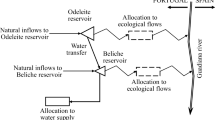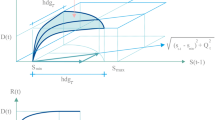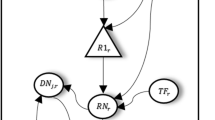Abstract
The purpose of this study is to evaluate Gharanghu multi-purpose reservoir system (East Azerbaijan, Iran) using efficiency indexes (EIs) affected by climate change. At first, the effects of climate change on inflow to the reservoir, as well as changes in the demand volume over a time interval of 30 years (2040–2069) are reviewed. Simulation results show that inflow to the reservoir is decreased in climate change interval compared to the baseline interval (1971–2000), so that comparison of long-term average monthly inflow to the reservoir in climate change interval is reduced about 25% compared to the baseline. Also, water demand in climate change interval will increase, namely volume of water demand for agricultural, drinking and industrial, and environmental in climate change interval is expected to increase by 20%. The simulation results of the water evaluation and planning (WEAP) model is used to determine EIs of multi-purpose reservoir system. Next, three scenarios of water supply for climate change interval are introduced to WEAP model, keeping variable of parameter related to water demand volume (based on different percentages of supply) and keeping constant of the parameter related to the volume of inflow to the reservoir. Results show that system EIs in climate change interval will have a disadvantage compared to the baseline. So that, reliability, vulnerability, resiliency and flexibility indexes in climate change interval based on 100% of water supply compared to the baseline will decrease 18%, increase 150%, decrease 33%, and decrease 47%, respectively. These indexes based on 85% of supply compared to the baseline will decrease 12%, increase 75%, decrease 30%, and decrease 39%, respectively. Also, those based on 70% of supply compared to the baseline will decrease 1%, will be without change, decrease 18%, and decrease 18%, respectively. Changes in indexes in future interval indicate the need to manage water resource development projects in the basin.












Similar content being viewed by others
References
Ashofteh P-S, Bozorg-Haddad O, Mariño MA (2013) Scenario assessment of streamflow simulation and its transition probability in future periods under climate change. Water Resour Manag 27(1):255–274
Ashofteh P-S, Bozorg-Haddad O, Mariño MA (2014) Discussion of “estimating the effects of climatic variability and human activities on streamflow in the Hutuo River Basin, China”. J Hydrol Eng 19(4):836–836. doi:10.1061/(ASCE)HE.1943-5584.0000834
Ashofteh P-S, Bozorg-Haddad O, Akbari-Alashti H, Mariño MA (2015a) Determination of irrigation allocation policy under climate change by genetic programming. J Irrig Drain Eng 141(4):04014059. doi:10.1061/(ASCE)IR.1943-4774.0000807
Ashofteh P-S, Bozorg-Haddad O, Loáiciga HA (2015b) Evaluation of climatic-change impacts on multi-objective reservoir operation with multiobjective genetic programming. J Water Resour Plan Manag 141(11):04015030. doi:10.1061/(ASCE)WR.1943-5452.0000540
Ashofteh P-S, Bozorg-Haddad O, Loáiciga HA, Mariño MA (2016) Evaluation of the impacts of climate variability and human activity on streamflow at the basin scale. J Irrig Drain Eng 142(8):04016028. doi:10.1061/(ASCE)IR.1943-4774.0001038
Assaf H, Saadeh M (2008) Assessing water quality management options in the upper Litani Basin, Lebanon, using an integrated GIS-based decision support system. Environ Model Softw 23(10–11):1327–1337. doi:10.1016/j.envsoft.2008.03.006
Bozorg-Haddad O, Ashofteh P-S, Rasoulzadeh-Gharibdousti S, Mariño MA (2014) Optimization model for design-operation of pumped-storage and hydropower systems. J Energy Eng 140(2):04013016. doi:10.1061/(ASCE)EY.1943-7897.0000169
Bozorg-Haddad O, Ashofteh P-S, Mariño MA (2015) Levee layouts and design optimization in protection of flood areas. J Irrig Drain Eng 141(8):04015004. doi:10.1061/(ASCE) IR.1943-4774.0000864
Carter TR (2007) General guideline on the use of scenario data for climate impact and adaptation assessment. Finnish Environment Institute, Helsinki, pp 30–40
Chau KW, Wu CL (2010) A hybrid model coupled with singular spectrum analysis for daily rainfall prediction. J Hydroinf 12(4):458–473
Chen XY, Chau KW, Busari AO (2015) A comparative study of population-based optimization algorithms for downstream river flow forecasting by a hybrid neural network model. Eng Appl Artif Intell 46:258–268
Droogers P, Aerts J (2005) Adaptation strategies to climate change and climate variability: a comparative study between seven contrasting river basin. Phys Chem Earth, Parts A/B/C 30(6–7):339–346. doi:10.1016/j.pce.2005.06.015
Gholami V, Chau KW, Fadaee F, Torkaman J, Ghaffari A (2015) Modeling of groundwater level fluctuations using dendrochronology in alluvial aquifers. J Hydrol 529:1060–1069
Haddad R, Nouiri I, Alshihabi O, Maßmann J, Huber M, Laghouane A, Yahiaoui H, Tarhouni J (2013) A decision support system to manage the groundwater of the Zeuss Koutine aquifer using the WEAP-MODFLOW framework. Water Resour Manag 27(7):1981–2000
Hashimoto T, Stedinger JR, Loucks DP (1982) Reliability, resiliency and vulnerability criteria for water resources system performance evaluation. Water Resour Res 18(1):14–20. doi:10.1029/WR018i001p00014
IPCC-TGCIA (1999) Guidelines on the use of scenario data for climate impact and adaptation assessment. Version 1. Prepared by Carter, T. R., Hulme, M. and Lal, M. Intergovernmental Panel on Climate Change. Task Group on Scenarios for Climate Impact Assessment, 69 p
IPCC (2011) IPCC Intergovernmental panel on climate change web site: organization page. http://www.ipcc.ch/organization/organization.shtlm
Jones RN, Page CM (2001) Assessing the risk of climate change on the water resources of the Macquarie River Catchment. In: Ghassemi F, Whetton P, Little R, Littleboy M (eds) Integrating models for natural resources management across disciplines, issues and scales (part 2). Modsim 2001 International Congress on Modelling and Simulation. Modelling and Simulation Society of Australia and New Zealand, Canberra, pp 673–678
Lévite H, Sally H, Cour J (2003) Testing water demand management scenarios in a water-stressed basin in South Africa: application of the WEAP model. Phys Chem Earth, Parts A/B/C 28(20–27):779–786. doi:10.1016/j.pce.2003.08.025
Li X, Zhao Y, Shi C, Sha J, Wang Z-L, Wang Y (2015) Application of water evaluation and planning (WEAP) model for water resources management strategy estimation in coastal Binhai new area, China. Ocean Coast Manag 106:97–109. doi:10.1016/j.ocecoaman.2015.01.016
Loucks DP (1997) Quantifying trends in system sustainability. Hydrol Sci J 42(4):513–530
Moy W-S, Cohon JL, Revelle CS (1986) A programming model for analysis of the reliability, resilience and vulnerability of a water supply reservoir. Water Resour Res 22(4):489–498. doi:10.1029/WR022i004p00489
Raskin P, Hansen E, Stavisky D, Zhu Z (1992) Simulation of water supply and demand in the Aral sea region. Water Int 17(2):55–67
Smith M (1988) Manual for CROPWAT version 5.2. FAO, Rome 45pp
Taormina R, Chau K-W (2015) Data-driven input variable selection for rainfall-runoff modeling using binary-coded particle swarm optimization and extreme learning machines. J Hydrol 529(3):1617–1632
Varela-Ortega C, Blanco-Gutiérrez I, Swartz CH, Downing TE (2011) Balancing groundwater conservation and rural livelihoods under water and climate uncertainties: an integrated hydro-economic modelling framework. Glob Environ Chang 21(2):604–619. doi:10.1016/j.gloenvcha.2010.12.001
Wang WC, Chau K-W, Xu D-M, Chen X-Y (2015) Improving forecasting accuracy of annual runoff time series using ARIMA based on EEMD decomposition. Water Resour Manag 29(8):2655–2675
Wilby RL, Harris I (2006) A framework for assessing uncertainties in climate change impacts: low flow scenarios for the river Thames, U.K. Water Resour Res 42(2):W02419
Wu CL, Chau KW, Li YS (2009) Methods to improve neural network performance in daily flows prediction. J Hydrol 372(1–4):80–93
Yilmaz B, Harmancioglu NB (2010) An indicator based assessment for water resources management in Gediz River basin, Turkey. Water Resour Manag 24(15):4359–4379. doi:10.1007/s11269-010-9663-3
Author information
Authors and Affiliations
Corresponding author
Rights and permissions
About this article
Cite this article
Ashofteh, PS., Rajaee, T. & Golfam, P. Assessment of Water Resources Development Projects under Conditions of Climate Change Using Efficiency Indexes (EIs). Water Resour Manage 31, 3723–3744 (2017). https://doi.org/10.1007/s11269-017-1701-y
Received:
Accepted:
Published:
Issue Date:
DOI: https://doi.org/10.1007/s11269-017-1701-y




